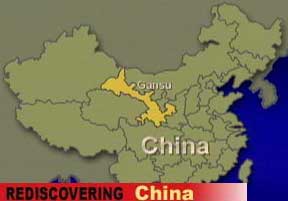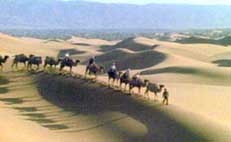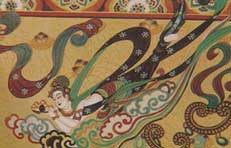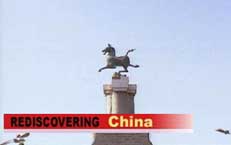  The Yellow River is refereed to as the Mother River of China. Lanzhou is the only provincial capital city that the river runs through. As a tribute to their mother river, the people of Lanzhou have erected this statue. It is a photographic must for any tourist, from China and abroad, who visits Lanzhou. The Yellow River is refereed to as the Mother River of China. Lanzhou is the only provincial capital city that the river runs through. As a tribute to their mother river, the people of Lanzhou have erected this statue. It is a photographic must for any tourist, from China and abroad, who visits Lanzhou.
The rafts made of sheepskin, used by previous generations of people who lived along the Yellow River in China, have now become rare. Their occasional presence renders a stroke of ancient colour to this modern city. Drifting down the river on the raft, you will see the Zhongshan Bridge, which is referred to as "the first bridge over the Yellow River." This iron bridge, which stretches for 240 meters across the river was built in 1909 and has witnessed all the changes along the Yellow River in the last century, most of which are about the water of Yellow River. The restless Yellow River runs through Gansu Province. In the past, the people here used this kind of waterwheel to draw water for irrigation. Erected in 1952, this waterwheel has 252 wheels and the largest two of which are 16.5 meters in diameter. This waterwheel sits just in Lanzhou, the capital city of Gansu Province.
 Lanzhou is the capital of Gansu Province. Gansu is a long thin region located in the middle of western China. From end to end Gansu is 1655 kms long, which is the same as the distance from Warsaw to London. But at its narrowest point, Gansu is only 25 kms wide. If you drove a car across this point it would only take about 1/2 hour. It's the Hexi Corridor that accounts for the province's unusually elongated shape; the corridor that the silk road caravans once came down, and which was once the only link between the west and China. Lanzhou is the capital of Gansu Province. Gansu is a long thin region located in the middle of western China. From end to end Gansu is 1655 kms long, which is the same as the distance from Warsaw to London. But at its narrowest point, Gansu is only 25 kms wide. If you drove a car across this point it would only take about 1/2 hour. It's the Hexi Corridor that accounts for the province's unusually elongated shape; the corridor that the silk road caravans once came down, and which was once the only link between the west and China.
The Silk Road served as an international link for the political, economic and cultural communication between ancient China and the West. Opening up before 200BC, the Silk Road boasted nearly ten centuries prosperity. Due to its position, Gansu at the forefront of China was one of the first Chinese regions to accept material and spiritual influence from the West. The integration of Chinese and Western culture in Gansu has lasted from the past into the present. Situated in along the upper reaches of the Yellow River, Gansu offers a variety of landforms. Mountains, and deserts including the Gobi respectively take up 1/3 of the total area of the province. Though they seem rather barren, many places are rich in underground resources, and 145 natural minerals are found in the area. The abundant water resources have also been utilized. Gansu is one of the major pastoral areas in China.
A comparatively independent and complete industrial system has been established in Gansu after more than four decades of development. Now Gansu functions not only as a key industrial center in west China but also as a national base for the production of energy and the mining of raw materials.
 The Lanzhou Chemical Industry Company is the first petrochemical base founded in China. More than 180 large and medium sized key enterprises in the province are undergoing a reformation of their stock system and the reconstruction their capital. Reform brings about pains as well as hopes. The Lanzhou Chemical Industry Company is the first petrochemical base founded in China. More than 180 large and medium sized key enterprises in the province are undergoing a reformation of their stock system and the reconstruction their capital. Reform brings about pains as well as hopes.
Gansu not only boasts chemical industry as an avenue for development, but she also has geographical, cultural and historical heritage that is strongly linked to all of China and even the world that can only arouse further great interest.
Today we're at the Binglingsi cave temples. These are just one example of the 20 or more cave relics that can be found in Gansu. The BLS caves contain 694 Buddhist statues, the largest one of which is 27 meters high. Also found in Gansu is the Hexi Corridor, which from a long history of Silk Road traffic remain many amazing cultural relics. For example, the world renowned bronze statue "The flying Horse", which is the symbol for Chinese tourism, was unearthed from the Han Dynasty Leitai tombs along the corridor.
 Gansu has a long history and spectacular scenery. The various ethnic groups and diverse cultural heritage found in Gansu indicate the origins of the Chinese nation. The Mogaoku Cave Temple in Dunhuang, one of the three examples of cave temple art found in China, is one of the oldest, richest and best-preserved cultural and art treasures in the world It is referred to as a " wonder of the world." Nowadays, this lavish historical and cultural heritage improve people's prosperity, providing a pivot for tourism economic growth. Gansu has a long history and spectacular scenery. The various ethnic groups and diverse cultural heritage found in Gansu indicate the origins of the Chinese nation. The Mogaoku Cave Temple in Dunhuang, one of the three examples of cave temple art found in China, is one of the oldest, richest and best-preserved cultural and art treasures in the world It is referred to as a " wonder of the world." Nowadays, this lavish historical and cultural heritage improve people's prosperity, providing a pivot for tourism economic growth.
2000 years ago Lanzhou was an important city for commercial trade along the ancient Silk Road. It played a central role in commerce between China, central Asia and Europe. For 1000 years camel teams carried silk, porcelain and fresh produce to the west, returning with pearls and medicine. Today Lanzhou is still the center for commercial trade and primary produce in northwest China.
Since 1950's Lanzhou has been the center of material exchange and business trade in northwest China Customers from far and near patronize the newly built department stores, which are well stocked with a variety of commodities, including many of the international namebrands, are rich in variety and plenteous in supply. In the morning, people gather in the square surrounded by department stores to exercise Chinese Gongfu. Most of them are warm-hearted and ready to help newcomers of the art.
There are few Chinese people coming to Gansu, but the typical Lanzhou stretched noodle is well known throughout China. This stretched noodle contains basic ingredients and though its production method looks simple, it requires some skill. The result is truly delicious and as people's rhythm of life gets faster and faster, it continues to be a popular fast food in China, as McDonald's is in the west, used in established restaurants throughout the country.
Created in about 1875, the beef noodle, a flavor typically enjoyed in the west, needs skill to cook and enjoys a wide popularity. When the people in Gansu are savouring the tasty beef noodle, they have not forgotten the challenges they face.
Reoccurring droughts have painted a yellow hue over Gansu and this lack of rainfall has been the cause of her poverty. After decades of effort to rejuvenate the ecology, a beginning has been made. Gansu now has a forest cover of 3.9%, and though this sounds minimal, it's a step toward alleviating Gansu's environmental problems.
Gansu is both blessed and cursed by nature. The province has fertile yellow earth that the Yellow River runs through, but the boundless Gobi desert also expands across other parts of the region. As one of the major plateau areas in China, Gansu is troubled by the lack of forestation and severe soil erosion. The ecological environment here is rather weak. The annual rainfall in Gansu is only about 300ml.These factors have attributed to the poverty and Gansu is seen as one of the poorer areas of China
Interview: Dr Zhou Minliang, Chinese Academy of Social Science
The promotion of water-saving irrigation, as well as the proper allocation and use of water may play a key role in the agricultural development and serve as a significant aspect of ecological improvement in Gansu Province. The rationing of water is especially crucial in being able to sustain the development of agriculture and stock-raising.
The Dingxi region is known in China for her poverty. The economic growth here is most hampered by the lack of water. People in Dingxi have now set about adjusting their rural industrial structure with an emphasis on the development of water-saving agriculture. As a result, the living standards here have seen a gradual rise. A young farmer named Jia Yongguo set up a company with his own self-raised funds to plant all kinds of fungus products.
Interview: Jia Yongguo, manager of Jinquan Fungus Company of Dingxi
The day lily is a kind of fungus that grows in cold temperatures. The Dingxi region is particularly suitable for day lilies. The day lily can grow throughout the year in Dingxi, while it is grown for only 6 months in the southern regions. What is more, it doesn't need much water at all. To grow US$1,200 worth of day lilies, you only need 30 tons of water. For most vegetables of the same value would need 300 tons of water, and for corn, 3000 tons of water would be needed. Therefore the day lily can save several hundred tons of water. And since Dingxi is extremely short of this resource the day lily is best suited here.
Many people in Gansu have found confidence in their future through the successful implementation of economic development which is in line with local conditions and the Chinese government's policy to develop west China.
Interview: Resident
People used to think that Gansu was underdeveloped, but the main reason why Gansu was lagging behind the East was because people here lacked an open mind. Now, since the government has strengthened its support for the West, people here seem to have a sense of urgency. It seems that they are anxious to act now and broaden their horizons. We can see the drive of development has brought hope to our lives here.
Carol Eames comes from Australia and now she is teaching English at Lanzhou University. She is delighted to see all the changes taken place around her.
Interview: Carol Eames, Australian Teacher
The support of the general population and many foreign friends to encourage the development of the west inspires the government in Gansu to further its economic growth.
Interview: Sun Ying, Secretary of Gansu Provincial Party Committee
Through the Western Development project, Gansu shall focus on changing from a primary economy based on natural resource sits superiority in natural resource into an industrial economy. To be more specific, her goal is to develop the nonferrous metal base in Gansu, build up a high-tech modern oil & gas chemical industry, develop the tourism in Gansu and build a Chinese herbal medicine processing base.
If you look through any travel magazine you will notice more and more exciting routes opening up in the west like Dunhuang, the Mogaoku Caves, Chengdu and Lhasa to name just a few. This year going west to enjoy beautiful scenery and exotic cultures is a popular choice, so I hope you've made your plans to travel in west China.
|









